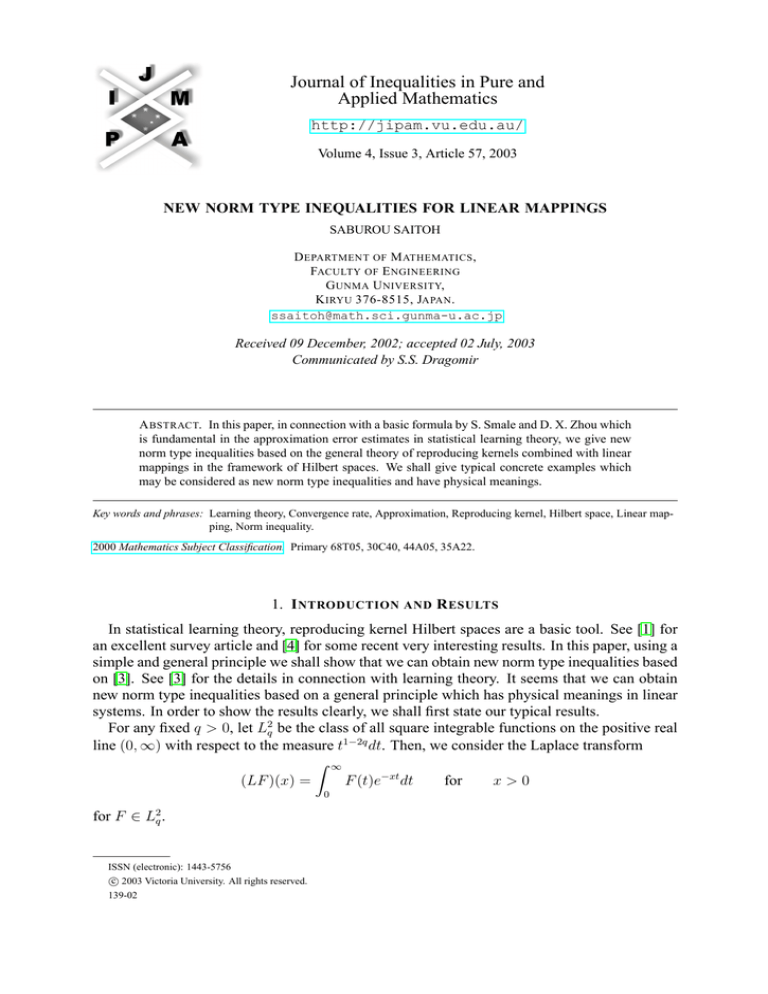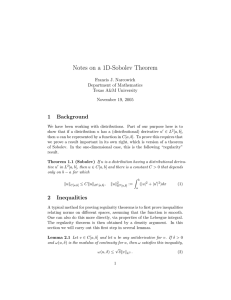
Journal of Inequalities in Pure and
Applied Mathematics
http://jipam.vu.edu.au/
Volume 4, Issue 3, Article 57, 2003
NEW NORM TYPE INEQUALITIES FOR LINEAR MAPPINGS
SABUROU SAITOH
D EPARTMENT OF M ATHEMATICS ,
FACULTY OF E NGINEERING
G UNMA U NIVERSITY,
K IRYU 376-8515, JAPAN .
ssaitoh@math.sci.gunma-u.ac.jp
Received 09 December, 2002; accepted 02 July, 2003
Communicated by S.S. Dragomir
A BSTRACT. In this paper, in connection with a basic formula by S. Smale and D. X. Zhou which
is fundamental in the approximation error estimates in statistical learning theory, we give new
norm type inequalities based on the general theory of reproducing kernels combined with linear
mappings in the framework of Hilbert spaces. We shall give typical concrete examples which
may be considered as new norm type inequalities and have physical meanings.
Key words and phrases: Learning theory, Convergence rate, Approximation, Reproducing kernel, Hilbert space, Linear mapping, Norm inequality.
2000 Mathematics Subject Classification. Primary 68T05, 30C40, 44A05, 35A22.
1. I NTRODUCTION AND R ESULTS
In statistical learning theory, reproducing kernel Hilbert spaces are a basic tool. See [1] for
an excellent survey article and [4] for some recent very interesting results. In this paper, using a
simple and general principle we shall show that we can obtain new norm type inequalities based
on [3]. See [3] for the details in connection with learning theory. It seems that we can obtain
new norm type inequalities based on a general principle which has physical meanings in linear
systems. In order to show the results clearly, we shall first state our typical results.
For any fixed q > 0, let L2q be the class of all square integrable functions on the positive real
line (0, ∞) with respect to the measure t1−2q dt. Then, we consider the Laplace transform
Z ∞
(LF )(x) =
F (t)e−xt dt
for
x>0
0
for F ∈ L2q .
ISSN (electronic): 1443-5756
c 2003 Victoria University. All rights reserved.
139-02
2
S ABUROU S AITOH
Theorem 1.1. For LF = f and LG = g, we obtain the inequality
Z ∞
1
inf
(f 0 (x) − g 0 (x))2 x2q+1 dx ≤ kF k2L2q
kGkL2 ≤R Γ(2q + 1) 0
q
R
1−
kF kL2q
!2
,
for kF kL2q ≥ R.
We shall consider the Weierstrass transform, for any fixed t > 0
Z ∞
(x − ξ)2
1
F (ξ) exp −
dξ,
uF (x, t) = √
4t
4πt −∞
for L2 (R, dξ) functions. Then,
Theorem 1.2. For uF (x, t) and uG (x, t), we have the inequality
inf kuF (·, t) − uG (·, t)kL2 ≤ kF kL2 1 −
kGkL2 ≤R
R
kF kL2
,
for kF kL2 ≥ R.
For any fixed a > 0 we shall consider the Hilbert space Fa consisting of entire functions f (z)
on C(z = x + iy) with finite norms
Z Z
a2
2
|f (z)|2 exp(−a2 |z|2 )dxdy.
kf kFa =
π
C
Then we have
Theorem 1.3. For any f and g ∈ Fa , we have the inequality
√
2
Z ∞
2π
R
2
2
2 2
kf kFa 1 −
,
inf
|f (x) − g(x)| exp(−a x )dx ≤
kgkFa ≤R −∞
a
kf kFa
for kf kFa ≥ R.
It was a pleasant suprise for the author that Professor Michael Plum was able to directly
derive a proof of Theorem 1.2 in a Problems and Remarks session in the 8th General Inequalities
Conference. In this paper, we will be able to give some general background for Theorem 1.2.
Furthermore, we can obtain various other norm inequalities of type Theorem 1.2.
2. A G ENERAL A PPROACH
AND
P ROOFS
The proofs of the theorems are based on a simple general principle, and on some deep and
delicate parts which depend on case by case, arguments.
We need the general theory of reproducing kernels which is combined with linear mappings
in the framework of Hilbert spaces in [2].
For any abstract set E and for any Hilbert (possibly finite–dimensional) space H, we shall
consider an H–valued function h on E
h : E −→ H
(2.1)
and the linear mapping for H
(2.2)
f (p) = (f , h(p))H
for f ∈ H
into a linear space comprising of functions {f (p)} on E. For this linear mapping, we consider
the function K(p, q) on E × E defined by
(2.3)
K(p, q) = (h(q), h(p))H
J. Inequal. Pure and Appl. Math., 4(3) Art. 57, 2003
on E × E.
http://jipam.vu.edu.au/
N EW N ORM T YPE I NEQUALITIES FOR L INEAR M APPINGS
3
Then, K(p, q) is a positive matrix on E; that is, for any finite points {pj } of E and for any
complex numbers {Cj },
XX
Cj Cj 0 K(pj 0 , pj ) ≥ 0.
j
j0
Then, by the fundamental theorem of Moore–Aronszajn, we have:
Proposition 2.1. For any positive matrix K(p, q) on E, there exists a uniquely determined
functional Hilbert space HK comprising of functions {f } on E and admitting the reproducing
kernel K(p, q) (RKHS HK ) satisfying and characterized by
K(·, q) ∈ HK for any q ∈ E
(2.4)
and, for any q ∈ E and for any f ∈ HK
f (q) = (f (·), K(·, q))HK .
(2.5)
Then in particular, we have the following fundamental results:
(I) For the RKHS HK admitting the reproducing kernel K(p, q) defined by (2.3), the images {f (p)} by (2.2) for H are characterized as the members of the RKHS HK .
(II) In general, we have the inequality in (2.2)
kf kHK ≤ kf kH ,
(2.6)
however, for any f ∈ HK there exists a uniquely determined f ∗ ∈ H satisfying
f (p) = (f ∗ , h(p))H
(2.7)
on E
and
kf kHK = kf ∗ kH .
(2.8)
In (2.6), the isometry holds if and only if {h(p); p ∈ E} is complete in H.
Here, we shall assume that
{h(p); p ∈ E}
is complete in H.
Therefore, in (2.2) we have the isometric identity
(2.9)
kf kHK = kf kH .
Now, for any f ∈ H we consider the approximation
(2.10)
inf
kgkH ≤R
kf − gk.
Of course, if kf kH ≤ R, there is no problem, since (2.10) is zero. The best approximation g∗ in
(2.10) is given by
Rf
g∗ =
kf kH
and we obtain the result, as we see from Schwarz’s inequality
R
(2.11)
inf kf − gk = kf kH 1 −
.
kgkH ≤R
kf kH
Now, we shall transform the estimate onto HK by using the linear mapping (2.2) and the
isometry (2.9) in the form
R
(2.12)
inf kf − gkHK = kf kH 1 −
kgkH ≤R
kf kH
for kf kH ≥ R.
J. Inequal. Pure and Appl. Math., 4(3) Art. 57, 2003
http://jipam.vu.edu.au/
4
S ABUROU S AITOH
In statistical learning theory, we have the linear mappings
Z
(2.13)
f (p) =
F (t)h(t, p)dm(t),
T
where F ∈ L2 (T, dm), and the integral kernels h(t, p) on T × T are Hilbert-Schmidt kernels
satisfying
Z Z
(2.14)
|h(t, p)|2 dm(t)dm(p) < ∞.
T ×T
In our formulation, this will mean that the images of (2.2) for H belong to H again. Then,
in the estimate (2.12) we will be able to consider a more concrete norm H than HK . However,
this part will be very delicate in the exact estimate of the norms in H and HK , as we can see
from the following examples.
Indeed, for our integral transforms in Theorems 1.1 and 1.2, the associated reproducing kernel
Hilbert spaces are realized as follows:
In Theorem 1.1,
Z ∞
∞
X
1
2
(2.15)
kf kHK =
|∂xj (x(f 0 (x))|2 x2j+2q−1 dx.
j!Γ(j
+
2q
+
1)
0
j=0
In Theorem 1.2,
(2.16)
kuF (·, t)k2HK
=
Z
∞
X
(2t)j
j=0
j!
∞
|∂xj uF (x, t)|2 dx.
−∞
In Theorem 1.3, we obtain the inequality
√
Z ∞
2π
(2.17)
|f (x)|2 exp(−a2 x2 )dx ≤
kf k2Fa .
a
−∞
See [2] for these results. In particular, note that inequality (2.17) is not trivial at all.
We take the simplest parts j = 0 in those realizations of the associated reproducing kernel
Hilbert spaces. Then, we obtain Theorems 1.1 and 1.2. From (2.17), we have Theorem 1.3.
This part of the theorems depends on case by case arguments and so, the results obtained are
intricate.
3. I NCOMPLETE C ASE
In the case that {h(p); p ∈ E} is not complete in H, similar estimates generally hold. We
shall give a typical example.
We shall consider the integral transform, for any fixed x
Z x+ct
Z ∞
1
1
(3.1)
uF (x, t) =
F (ξ)dξ =
F (ξ)θ(ct − |x − ξ|)dξ,
2π x−ct
2π −∞
which gives the solution of the wave equation
2
∂ 2 uF (x, t)
2 ∂ uF (x, t)
=c
∂t2
∂x2
(c > 0,
constant)
satisfying
∂uF (x, t)
|t=0 = F (x), u(x, 0) = 0 on
∂t
J. Inequal. Pure and Appl. Math., 4(3) Art. 57, 2003
R.
http://jipam.vu.edu.au/
N EW N ORM T YPE I NEQUALITIES FOR L INEAR M APPINGS
5
Then we have the identity
Z
(3.2)
2c
0
∞
∂uF (x, t)
∂t
2
Z
∞
dt = min
F (ξ)2 dξ
−∞
where the minimum is taken over all the functions F ∈ L2 (R) = L2 satisfying
Z ∞
1
uF (x, t) =
F (ξ)θ(ct − |x − ξ|)dξ,
2π −∞
for all t > 0 ([2, pp. 143-147]). Then, we obtain
Theorem 3.1. In the integral transform (3.1) for L2 functions F , we have the inequality
√
∂uF (x, t) ∂uG (x, t)
R
inf
2ck
−
kL2 (0,∞) ≥ kF kL2 1 −
kGkL2 ≤R
∂t
∂t
kF kL2
for kF kL2 ≤ R.
R EFERENCES
[1] F. CUCKER AND S. SMALE, On the mathematical foundations of learning, Bull. of Amer. Math.
Soc., 39 (2001), 1–49.
[2] S. SAITOH, Integral Transforms, Reproducing Kernels and Their Applications, Pitman Res. Notes
in Math. Series, 369 (1997), Addison Wesley Longman, UK.
[3] S. SAITOH, New type approximation error and convergence rate estimates in statistical learning
theory, J. Analysis and Applications, 1 (2003), 33–39.
[4] S. SMALE AND D. X. ZHOU, Estimating the approximation error in learning theory, Anal. Appl., 1
(2003), 17–41.
J. Inequal. Pure and Appl. Math., 4(3) Art. 57, 2003
http://jipam.vu.edu.au/






